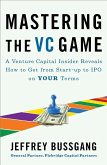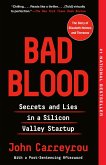- Broschiertes Buch
- Merkliste
- Auf die Merkliste
- Bewerten Bewerten
- Teilen
- Produkt teilen
- Produkterinnerung
- Produkterinnerung
This accessible text provides an insight into the growing global trend of crowdfunding as a source of entrepreneurial finance.
Grounded in academic literature, this book looks at the micro and macro issues within crowdfunding, from the entrepreneur's access to finance at the business level, to the role of government in regulating the market. It helps the reader develop a sound understanding of crowdfunding as a source of finance, the crowdfunding process and potential options when faced with start-up funding issues.
A range of international case studies of successful and unsuccessful…mehr
Andere Kunden interessierten sich auch für
![Crowdfunding European Business Crowdfunding European Business]() Antonella Francesca CicchielloCrowdfunding European Business58,99 €
Antonella Francesca CicchielloCrowdfunding European Business58,99 €![Crowdfunding for Entrepreneurs Crowdfunding for Entrepreneurs]() Francesca Di Pietro (Trinity College Dubli Trinity Business SchoolCrowdfunding for Entrepreneurs56,99 €
Francesca Di Pietro (Trinity College Dubli Trinity Business SchoolCrowdfunding for Entrepreneurs56,99 €![Alternative Finance Alternative Finance]() Alternative Finance142,99 €
Alternative Finance142,99 €![Social Entrepreneurship for Development Social Entrepreneurship for Development]() Margaret BrindleSocial Entrepreneurship for Development200,99 €
Margaret BrindleSocial Entrepreneurship for Development200,99 €![Mastering the VC Game Mastering the VC Game]() Jeffrey BussgangMastering the VC Game15,99 €
Jeffrey BussgangMastering the VC Game15,99 €![Bad Blood Bad Blood]() John CarreyrouBad Blood9,49 €
John CarreyrouBad Blood9,49 €![Artificial Intelligence and Blockchain for Social Impact Artificial Intelligence and Blockchain for Social Impact]() Wolfgang Spiess-KnaflArtificial Intelligence and Blockchain for Social Impact45,99 €
Wolfgang Spiess-KnaflArtificial Intelligence and Blockchain for Social Impact45,99 €-
-
-
This accessible text provides an insight into the growing global trend of crowdfunding as a source of entrepreneurial finance.
Grounded in academic literature, this book looks at the micro and macro issues within crowdfunding, from the entrepreneur's access to finance at the business level, to the role of government in regulating the market. It helps the reader develop a sound understanding of crowdfunding as a source of finance, the crowdfunding process and potential options when faced with start-up funding issues.
A range of international case studies of successful and unsuccessful crowdfunding campaigns help readers to apply theory to real-life scenarios. Readers are also supported throughout the book with chapter objectives and summaries, key terms, discussion questions and further reading guidance. Instructor materials such as slides and test questions are available as digital supplements.
Crowdfunding and Entrepreneurship will be a valuable resourcefor students of new venture creation and entrepreneurial finance, as well as entrepreneurs exploring crowdfunding as an option for business development.
Grounded in academic literature, this book looks at the micro and macro issues within crowdfunding, from the entrepreneur's access to finance at the business level, to the role of government in regulating the market. It helps the reader develop a sound understanding of crowdfunding as a source of finance, the crowdfunding process and potential options when faced with start-up funding issues.
A range of international case studies of successful and unsuccessful crowdfunding campaigns help readers to apply theory to real-life scenarios. Readers are also supported throughout the book with chapter objectives and summaries, key terms, discussion questions and further reading guidance. Instructor materials such as slides and test questions are available as digital supplements.
Crowdfunding and Entrepreneurship will be a valuable resourcefor students of new venture creation and entrepreneurial finance, as well as entrepreneurs exploring crowdfunding as an option for business development.
Produktdetails
- Produktdetails
- Verlag: Routledge / Taylor & Francis
- Seitenzahl: 298
- Erscheinungstermin: 11. Dezember 2023
- Englisch
- Abmessung: 234mm x 156mm x 16mm
- Gewicht: 453g
- ISBN-13: 9781032046280
- ISBN-10: 1032046287
- Artikelnr.: 68711646
- Herstellerkennzeichnung
- Libri GmbH
- Europaallee 1
- 36244 Bad Hersfeld
- gpsr@libri.de
- Verlag: Routledge / Taylor & Francis
- Seitenzahl: 298
- Erscheinungstermin: 11. Dezember 2023
- Englisch
- Abmessung: 234mm x 156mm x 16mm
- Gewicht: 453g
- ISBN-13: 9781032046280
- ISBN-10: 1032046287
- Artikelnr.: 68711646
- Herstellerkennzeichnung
- Libri GmbH
- Europaallee 1
- 36244 Bad Hersfeld
- gpsr@libri.de
Ignatius Ekanem is Senior Lecturer in Business and Management at Middlesex University Business School, London. He is the author of Writing a Business Plan: A Practical Guide, also from Routledge. Steve Ideh is a chartered accountant and certified management consultant with over 25 years' experience in finance. He is an adjunct faculty member at several business schools and a regular speaker at entrepreneurship events.
Table of contents
Preface
Acknowledgements
About the authors
Appendix: Links to Support Students
Preface
Acknowledgements
About the authors
- Crowdfunding and Entrepreneurship: Setting the Stage
- What is Crowdfunding?
- The Financial Behaviour of Entrepreneurs in Relation to Crowdfunding
- Exploring Resource-Based Theory in Crowdfunding
- Reducing the Risk of Information Asymmetry in Crowdfunding
- The Trend in The Market of Digital Finance
- The Features of a Good Crowdfunding Campaign
- The Problems Encountered by Entrepreneurs in Sourcing Crowdfunding
- The Role of Social Relationships and Networking in Sourcing Crowdfunding
- The Scope of Crowdfunding as A Niche Market
- Areas for Government Assistance
- Case studies of successful crowdfunding campaigns
Introduction
Definition of small and medium enterprises (SMEs)
Characteristics of successful entrepreneurs
Capital structure
The differences between small firms' and large firms' capital structure
Sources of entrepreneurial finance
Summary
Recommended reading
References
Introduction
Definition of crowdfunding
Features of crowdfunding
Evolution and development of crowdfunding
Types of crowdfunding
Crowdfunding platforms
Platform intermediaries
Characteristics of crowdfunding entrepreneurs
Benefits of crowdfunding
Summary
Recommended reading
References
Introduction
Pecking order and trade-off theories
Static trade-off versus pecking order in small firms
Crowdfunding and the firm's life cycle
Types of entrepreneurship
Summary
Recommended reading
References
Introduction
Origin and background of Resource-Based Theory
The Resource-Based Theory
Types of resources
Assumptions of Resource-Based Theory
The characteristics of strategic resources
Evaluation of Resources
Assembling resources through Resource-Based Theory
Critiques of Resource-Based Theory
Linking resources with capabilities
Understanding resources exchanged in crowdfunding
The Resource Exchange Theory
Crowdfunding through the lens of Resource Exchange Theory
Crowdfunding: resources, capabilities and stakeholders
Stakeholder theory and crowdfunding
Crowdfunding: stakeholders analysis and involvement
Crowdfunding: the role of financiers
The characteristics of stakeholders and resource exchange process in crowdfunding
Summary
Recommended reading
References
Introduction
What is information asymmetry?
Advantages and disadvantages of information asymmetry
Information asymmetry in crowdfunding
Causes of information asymmetry
Strategies for reducing information asymmetry in crowdfunding
Summary
Recommended reading
References
Introduction
The concept of financial inclusion
Digital finance
Types of digital finance
The benefits of digital finance
FinTech
Digital technologies enable financial inclusion
FinTech trends
Summary
Recommended reading
References
Introduction
Empirical studies
The ten commandments of crowdfunding
Crowdfunding campaign timelines
The pitch
The role of effective communication
Summary
Recommended reading
References
Introduction
Challenges of crowdfunding
The problems of choosing the right crowdfunding platform
The problems of building up interest
Avoiding/minimizing crowdfunding minefields
Summary
Recommended reading
References
Introduction
Social relationship and networking in crowdfunding
The differences between social network theory and business network theory
Networking and equity crowdfunding
The network dynamics in crowdfunding
Relational benefits of networks in crowdfunding
Social media usage in crowdfunding
The interplay of social media messages and social ties
Social network dynamics in charitable crowdfunding
Social interaction in charitable crowdfunding
Summary
Recommended reading
References
Introduction
What is a niche market?
The catalysts for crowdfunding
The features of crowdfunding as a niche market
Crowdfunding: closing the finance gap for small firms as a niche market
Summary
Recommended reading
References
Introduction
Regulatory support of government
Review of the regulatory framework for crowdfunding
The need for harmonized EU regulation
The new EU legislative framework
JOBS vs. ECSPR
Other areas of government support
Blockchain technology in crowdfunding
Peer-to-peer crowdfunding for local governments
Summary
Recommended reading
References
Introduction
Case study 1
Case study 2
Case study 3
Case study 4
Summary
Recommended reading
References
Appendix: Links to Support Students
Table of contents
Preface
Acknowledgements
About the authors
1. Crowdfunding and Entrepreneurship: Setting the Stage
Introduction
Definition of small and medium enterprises (SMEs)
Characteristics of successful entrepreneurs
Capital structure
The differences between small firms' and large firms' capital
structure
Sources of entrepreneurial finance
Summary
Recommended reading
References
2. What is Crowdfunding?
Introduction
Definition of crowdfunding
Features of crowdfunding
Evolution and development of crowdfunding
Types of crowdfunding
Crowdfunding platforms
Platform intermediaries
Characteristics of crowdfunding entrepreneurs
Benefits of crowdfunding
Summary
Recommended reading
References
3. The Financial Behaviour of Entrepreneurs in Relation to Crowdfunding
Introduction
Pecking order and trade-off theories
Static trade-off versus pecking order in small firms
Crowdfunding and the firm's life cycle
Types of entrepreneurship
Summary
Recommended reading
References
4. Exploring Resource-Based Theory in Crowdfunding
Introduction
Origin and background of Resource-Based Theory
The Resource-Based Theory
Types of resources
Assumptions of Resource-Based Theory
The characteristics of strategic resources
Evaluation of Resources
Assembling resources through Resource-Based Theory
Critiques of Resource-Based Theory
Linking resources with capabilities
Understanding resources exchanged in crowdfunding
The Resource Exchange Theory
Crowdfunding through the lens of Resource Exchange Theory
Crowdfunding: resources, capabilities and stakeholders
Stakeholder theory and crowdfunding
Crowdfunding: stakeholders analysis and involvement
Crowdfunding: the role of financiers
The characteristics of stakeholders and resource exchange process in
crowdfunding
Summary
Recommended reading
References
5. Reducing the Risk of Information Asymmetry in Crowdfunding
Introduction
What is information asymmetry?
Advantages and disadvantages of information asymmetry
Information asymmetry in crowdfunding
Causes of information asymmetry
Strategies for reducing information asymmetry in crowdfunding
Summary
Recommended reading
References
6. The Trend in The Market of Digital Finance
Introduction
The concept of financial inclusion
Digital finance
Types of digital finance
The benefits of digital finance
FinTech
Digital technologies enable financial inclusion
FinTech trends
Summary
Recommended reading
References
7. The Features of a Good Crowdfunding Campaign
Introduction
Empirical studies
The ten commandments of crowdfunding
Crowdfunding campaign timelines
The pitch
The role of effective communication
Summary
Recommended reading
References
8. The Problems Encountered by Entrepreneurs in Sourcing Crowdfunding
Introduction
Challenges of crowdfunding
The problems of choosing the right crowdfunding platform
The problems of building up interest
Avoiding/minimizing crowdfunding minefields
Summary
Recommended reading
References
9. The Role of Social Relationships and Networking in Sourcing
Crowdfunding
Introduction
Social relationship and networking in crowdfunding
The differences between social network theory and business network
theory
Networking and equity crowdfunding
The network dynamics in crowdfunding
Relational benefits of networks in crowdfunding
Social media usage in crowdfunding
The interplay of social media messages and social ties
Social network dynamics in charitable crowdfunding
Social interaction in charitable crowdfunding
Summary
Recommended reading
References
10. The Scope of Crowdfunding as A Niche Market
Introduction
What is a niche market?
The catalysts for crowdfunding
The features of crowdfunding as a niche market
Crowdfunding: closing the finance gap for small firms as a niche
market
Summary
Recommended reading
References
11. Areas for Government Assistance
Introduction
Regulatory support of government
Review of the regulatory framework for crowdfunding
The need for harmonized EU regulation
The new EU legislative framework
JOBS vs. ECSPR
Other areas of government support
Blockchain technology in crowdfunding
Peer-to-peer crowdfunding for local governments
Summary
Recommended reading
References
12. Case studies of successful crowdfunding campaigns
Introduction
Case study 1
Case study 2
Case study 3
Case study 4
Summary
Recommended reading
References
Appendix: Links to Support Students
Preface
Acknowledgements
About the authors
1. Crowdfunding and Entrepreneurship: Setting the Stage
Introduction
Definition of small and medium enterprises (SMEs)
Characteristics of successful entrepreneurs
Capital structure
The differences between small firms' and large firms' capital
structure
Sources of entrepreneurial finance
Summary
Recommended reading
References
2. What is Crowdfunding?
Introduction
Definition of crowdfunding
Features of crowdfunding
Evolution and development of crowdfunding
Types of crowdfunding
Crowdfunding platforms
Platform intermediaries
Characteristics of crowdfunding entrepreneurs
Benefits of crowdfunding
Summary
Recommended reading
References
3. The Financial Behaviour of Entrepreneurs in Relation to Crowdfunding
Introduction
Pecking order and trade-off theories
Static trade-off versus pecking order in small firms
Crowdfunding and the firm's life cycle
Types of entrepreneurship
Summary
Recommended reading
References
4. Exploring Resource-Based Theory in Crowdfunding
Introduction
Origin and background of Resource-Based Theory
The Resource-Based Theory
Types of resources
Assumptions of Resource-Based Theory
The characteristics of strategic resources
Evaluation of Resources
Assembling resources through Resource-Based Theory
Critiques of Resource-Based Theory
Linking resources with capabilities
Understanding resources exchanged in crowdfunding
The Resource Exchange Theory
Crowdfunding through the lens of Resource Exchange Theory
Crowdfunding: resources, capabilities and stakeholders
Stakeholder theory and crowdfunding
Crowdfunding: stakeholders analysis and involvement
Crowdfunding: the role of financiers
The characteristics of stakeholders and resource exchange process in
crowdfunding
Summary
Recommended reading
References
5. Reducing the Risk of Information Asymmetry in Crowdfunding
Introduction
What is information asymmetry?
Advantages and disadvantages of information asymmetry
Information asymmetry in crowdfunding
Causes of information asymmetry
Strategies for reducing information asymmetry in crowdfunding
Summary
Recommended reading
References
6. The Trend in The Market of Digital Finance
Introduction
The concept of financial inclusion
Digital finance
Types of digital finance
The benefits of digital finance
FinTech
Digital technologies enable financial inclusion
FinTech trends
Summary
Recommended reading
References
7. The Features of a Good Crowdfunding Campaign
Introduction
Empirical studies
The ten commandments of crowdfunding
Crowdfunding campaign timelines
The pitch
The role of effective communication
Summary
Recommended reading
References
8. The Problems Encountered by Entrepreneurs in Sourcing Crowdfunding
Introduction
Challenges of crowdfunding
The problems of choosing the right crowdfunding platform
The problems of building up interest
Avoiding/minimizing crowdfunding minefields
Summary
Recommended reading
References
9. The Role of Social Relationships and Networking in Sourcing
Crowdfunding
Introduction
Social relationship and networking in crowdfunding
The differences between social network theory and business network
theory
Networking and equity crowdfunding
The network dynamics in crowdfunding
Relational benefits of networks in crowdfunding
Social media usage in crowdfunding
The interplay of social media messages and social ties
Social network dynamics in charitable crowdfunding
Social interaction in charitable crowdfunding
Summary
Recommended reading
References
10. The Scope of Crowdfunding as A Niche Market
Introduction
What is a niche market?
The catalysts for crowdfunding
The features of crowdfunding as a niche market
Crowdfunding: closing the finance gap for small firms as a niche
market
Summary
Recommended reading
References
11. Areas for Government Assistance
Introduction
Regulatory support of government
Review of the regulatory framework for crowdfunding
The need for harmonized EU regulation
The new EU legislative framework
JOBS vs. ECSPR
Other areas of government support
Blockchain technology in crowdfunding
Peer-to-peer crowdfunding for local governments
Summary
Recommended reading
References
12. Case studies of successful crowdfunding campaigns
Introduction
Case study 1
Case study 2
Case study 3
Case study 4
Summary
Recommended reading
References
Appendix: Links to Support Students
Table of contents
Preface
Acknowledgements
About the authors
Appendix: Links to Support Students
Preface
Acknowledgements
About the authors
- Crowdfunding and Entrepreneurship: Setting the Stage
- What is Crowdfunding?
- The Financial Behaviour of Entrepreneurs in Relation to Crowdfunding
- Exploring Resource-Based Theory in Crowdfunding
- Reducing the Risk of Information Asymmetry in Crowdfunding
- The Trend in The Market of Digital Finance
- The Features of a Good Crowdfunding Campaign
- The Problems Encountered by Entrepreneurs in Sourcing Crowdfunding
- The Role of Social Relationships and Networking in Sourcing Crowdfunding
- The Scope of Crowdfunding as A Niche Market
- Areas for Government Assistance
- Case studies of successful crowdfunding campaigns
Introduction
Definition of small and medium enterprises (SMEs)
Characteristics of successful entrepreneurs
Capital structure
The differences between small firms' and large firms' capital structure
Sources of entrepreneurial finance
Summary
Recommended reading
References
Introduction
Definition of crowdfunding
Features of crowdfunding
Evolution and development of crowdfunding
Types of crowdfunding
Crowdfunding platforms
Platform intermediaries
Characteristics of crowdfunding entrepreneurs
Benefits of crowdfunding
Summary
Recommended reading
References
Introduction
Pecking order and trade-off theories
Static trade-off versus pecking order in small firms
Crowdfunding and the firm's life cycle
Types of entrepreneurship
Summary
Recommended reading
References
Introduction
Origin and background of Resource-Based Theory
The Resource-Based Theory
Types of resources
Assumptions of Resource-Based Theory
The characteristics of strategic resources
Evaluation of Resources
Assembling resources through Resource-Based Theory
Critiques of Resource-Based Theory
Linking resources with capabilities
Understanding resources exchanged in crowdfunding
The Resource Exchange Theory
Crowdfunding through the lens of Resource Exchange Theory
Crowdfunding: resources, capabilities and stakeholders
Stakeholder theory and crowdfunding
Crowdfunding: stakeholders analysis and involvement
Crowdfunding: the role of financiers
The characteristics of stakeholders and resource exchange process in crowdfunding
Summary
Recommended reading
References
Introduction
What is information asymmetry?
Advantages and disadvantages of information asymmetry
Information asymmetry in crowdfunding
Causes of information asymmetry
Strategies for reducing information asymmetry in crowdfunding
Summary
Recommended reading
References
Introduction
The concept of financial inclusion
Digital finance
Types of digital finance
The benefits of digital finance
FinTech
Digital technologies enable financial inclusion
FinTech trends
Summary
Recommended reading
References
Introduction
Empirical studies
The ten commandments of crowdfunding
Crowdfunding campaign timelines
The pitch
The role of effective communication
Summary
Recommended reading
References
Introduction
Challenges of crowdfunding
The problems of choosing the right crowdfunding platform
The problems of building up interest
Avoiding/minimizing crowdfunding minefields
Summary
Recommended reading
References
Introduction
Social relationship and networking in crowdfunding
The differences between social network theory and business network theory
Networking and equity crowdfunding
The network dynamics in crowdfunding
Relational benefits of networks in crowdfunding
Social media usage in crowdfunding
The interplay of social media messages and social ties
Social network dynamics in charitable crowdfunding
Social interaction in charitable crowdfunding
Summary
Recommended reading
References
Introduction
What is a niche market?
The catalysts for crowdfunding
The features of crowdfunding as a niche market
Crowdfunding: closing the finance gap for small firms as a niche market
Summary
Recommended reading
References
Introduction
Regulatory support of government
Review of the regulatory framework for crowdfunding
The need for harmonized EU regulation
The new EU legislative framework
JOBS vs. ECSPR
Other areas of government support
Blockchain technology in crowdfunding
Peer-to-peer crowdfunding for local governments
Summary
Recommended reading
References
Introduction
Case study 1
Case study 2
Case study 3
Case study 4
Summary
Recommended reading
References
Appendix: Links to Support Students
Table of contents
Preface
Acknowledgements
About the authors
1. Crowdfunding and Entrepreneurship: Setting the Stage
Introduction
Definition of small and medium enterprises (SMEs)
Characteristics of successful entrepreneurs
Capital structure
The differences between small firms' and large firms' capital
structure
Sources of entrepreneurial finance
Summary
Recommended reading
References
2. What is Crowdfunding?
Introduction
Definition of crowdfunding
Features of crowdfunding
Evolution and development of crowdfunding
Types of crowdfunding
Crowdfunding platforms
Platform intermediaries
Characteristics of crowdfunding entrepreneurs
Benefits of crowdfunding
Summary
Recommended reading
References
3. The Financial Behaviour of Entrepreneurs in Relation to Crowdfunding
Introduction
Pecking order and trade-off theories
Static trade-off versus pecking order in small firms
Crowdfunding and the firm's life cycle
Types of entrepreneurship
Summary
Recommended reading
References
4. Exploring Resource-Based Theory in Crowdfunding
Introduction
Origin and background of Resource-Based Theory
The Resource-Based Theory
Types of resources
Assumptions of Resource-Based Theory
The characteristics of strategic resources
Evaluation of Resources
Assembling resources through Resource-Based Theory
Critiques of Resource-Based Theory
Linking resources with capabilities
Understanding resources exchanged in crowdfunding
The Resource Exchange Theory
Crowdfunding through the lens of Resource Exchange Theory
Crowdfunding: resources, capabilities and stakeholders
Stakeholder theory and crowdfunding
Crowdfunding: stakeholders analysis and involvement
Crowdfunding: the role of financiers
The characteristics of stakeholders and resource exchange process in
crowdfunding
Summary
Recommended reading
References
5. Reducing the Risk of Information Asymmetry in Crowdfunding
Introduction
What is information asymmetry?
Advantages and disadvantages of information asymmetry
Information asymmetry in crowdfunding
Causes of information asymmetry
Strategies for reducing information asymmetry in crowdfunding
Summary
Recommended reading
References
6. The Trend in The Market of Digital Finance
Introduction
The concept of financial inclusion
Digital finance
Types of digital finance
The benefits of digital finance
FinTech
Digital technologies enable financial inclusion
FinTech trends
Summary
Recommended reading
References
7. The Features of a Good Crowdfunding Campaign
Introduction
Empirical studies
The ten commandments of crowdfunding
Crowdfunding campaign timelines
The pitch
The role of effective communication
Summary
Recommended reading
References
8. The Problems Encountered by Entrepreneurs in Sourcing Crowdfunding
Introduction
Challenges of crowdfunding
The problems of choosing the right crowdfunding platform
The problems of building up interest
Avoiding/minimizing crowdfunding minefields
Summary
Recommended reading
References
9. The Role of Social Relationships and Networking in Sourcing
Crowdfunding
Introduction
Social relationship and networking in crowdfunding
The differences between social network theory and business network
theory
Networking and equity crowdfunding
The network dynamics in crowdfunding
Relational benefits of networks in crowdfunding
Social media usage in crowdfunding
The interplay of social media messages and social ties
Social network dynamics in charitable crowdfunding
Social interaction in charitable crowdfunding
Summary
Recommended reading
References
10. The Scope of Crowdfunding as A Niche Market
Introduction
What is a niche market?
The catalysts for crowdfunding
The features of crowdfunding as a niche market
Crowdfunding: closing the finance gap for small firms as a niche
market
Summary
Recommended reading
References
11. Areas for Government Assistance
Introduction
Regulatory support of government
Review of the regulatory framework for crowdfunding
The need for harmonized EU regulation
The new EU legislative framework
JOBS vs. ECSPR
Other areas of government support
Blockchain technology in crowdfunding
Peer-to-peer crowdfunding for local governments
Summary
Recommended reading
References
12. Case studies of successful crowdfunding campaigns
Introduction
Case study 1
Case study 2
Case study 3
Case study 4
Summary
Recommended reading
References
Appendix: Links to Support Students
Preface
Acknowledgements
About the authors
1. Crowdfunding and Entrepreneurship: Setting the Stage
Introduction
Definition of small and medium enterprises (SMEs)
Characteristics of successful entrepreneurs
Capital structure
The differences between small firms' and large firms' capital
structure
Sources of entrepreneurial finance
Summary
Recommended reading
References
2. What is Crowdfunding?
Introduction
Definition of crowdfunding
Features of crowdfunding
Evolution and development of crowdfunding
Types of crowdfunding
Crowdfunding platforms
Platform intermediaries
Characteristics of crowdfunding entrepreneurs
Benefits of crowdfunding
Summary
Recommended reading
References
3. The Financial Behaviour of Entrepreneurs in Relation to Crowdfunding
Introduction
Pecking order and trade-off theories
Static trade-off versus pecking order in small firms
Crowdfunding and the firm's life cycle
Types of entrepreneurship
Summary
Recommended reading
References
4. Exploring Resource-Based Theory in Crowdfunding
Introduction
Origin and background of Resource-Based Theory
The Resource-Based Theory
Types of resources
Assumptions of Resource-Based Theory
The characteristics of strategic resources
Evaluation of Resources
Assembling resources through Resource-Based Theory
Critiques of Resource-Based Theory
Linking resources with capabilities
Understanding resources exchanged in crowdfunding
The Resource Exchange Theory
Crowdfunding through the lens of Resource Exchange Theory
Crowdfunding: resources, capabilities and stakeholders
Stakeholder theory and crowdfunding
Crowdfunding: stakeholders analysis and involvement
Crowdfunding: the role of financiers
The characteristics of stakeholders and resource exchange process in
crowdfunding
Summary
Recommended reading
References
5. Reducing the Risk of Information Asymmetry in Crowdfunding
Introduction
What is information asymmetry?
Advantages and disadvantages of information asymmetry
Information asymmetry in crowdfunding
Causes of information asymmetry
Strategies for reducing information asymmetry in crowdfunding
Summary
Recommended reading
References
6. The Trend in The Market of Digital Finance
Introduction
The concept of financial inclusion
Digital finance
Types of digital finance
The benefits of digital finance
FinTech
Digital technologies enable financial inclusion
FinTech trends
Summary
Recommended reading
References
7. The Features of a Good Crowdfunding Campaign
Introduction
Empirical studies
The ten commandments of crowdfunding
Crowdfunding campaign timelines
The pitch
The role of effective communication
Summary
Recommended reading
References
8. The Problems Encountered by Entrepreneurs in Sourcing Crowdfunding
Introduction
Challenges of crowdfunding
The problems of choosing the right crowdfunding platform
The problems of building up interest
Avoiding/minimizing crowdfunding minefields
Summary
Recommended reading
References
9. The Role of Social Relationships and Networking in Sourcing
Crowdfunding
Introduction
Social relationship and networking in crowdfunding
The differences between social network theory and business network
theory
Networking and equity crowdfunding
The network dynamics in crowdfunding
Relational benefits of networks in crowdfunding
Social media usage in crowdfunding
The interplay of social media messages and social ties
Social network dynamics in charitable crowdfunding
Social interaction in charitable crowdfunding
Summary
Recommended reading
References
10. The Scope of Crowdfunding as A Niche Market
Introduction
What is a niche market?
The catalysts for crowdfunding
The features of crowdfunding as a niche market
Crowdfunding: closing the finance gap for small firms as a niche
market
Summary
Recommended reading
References
11. Areas for Government Assistance
Introduction
Regulatory support of government
Review of the regulatory framework for crowdfunding
The need for harmonized EU regulation
The new EU legislative framework
JOBS vs. ECSPR
Other areas of government support
Blockchain technology in crowdfunding
Peer-to-peer crowdfunding for local governments
Summary
Recommended reading
References
12. Case studies of successful crowdfunding campaigns
Introduction
Case study 1
Case study 2
Case study 3
Case study 4
Summary
Recommended reading
References
Appendix: Links to Support Students








